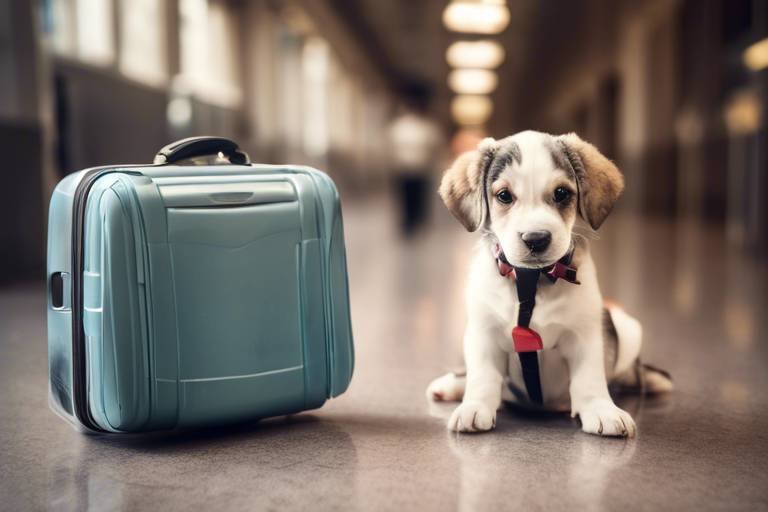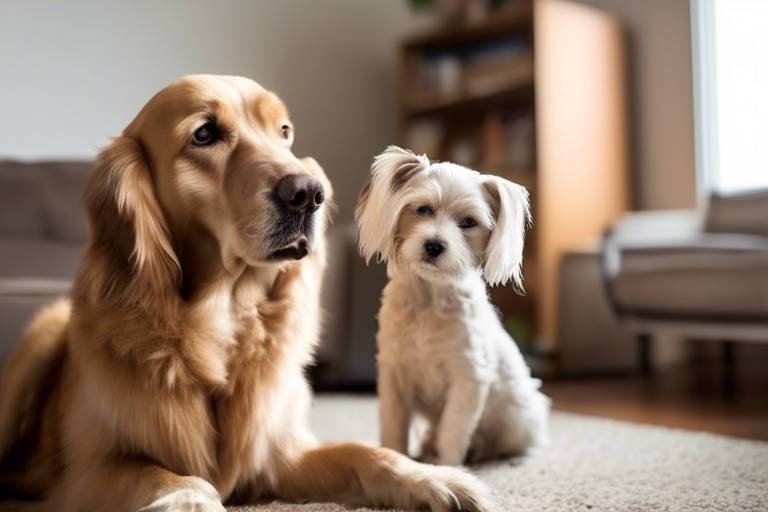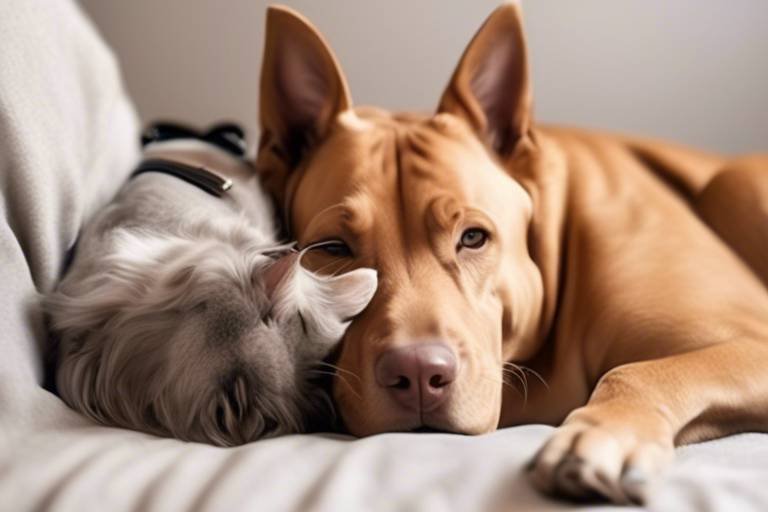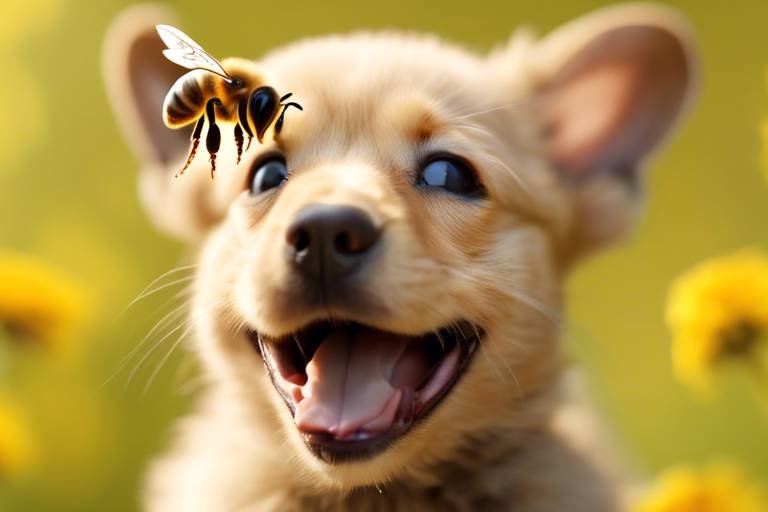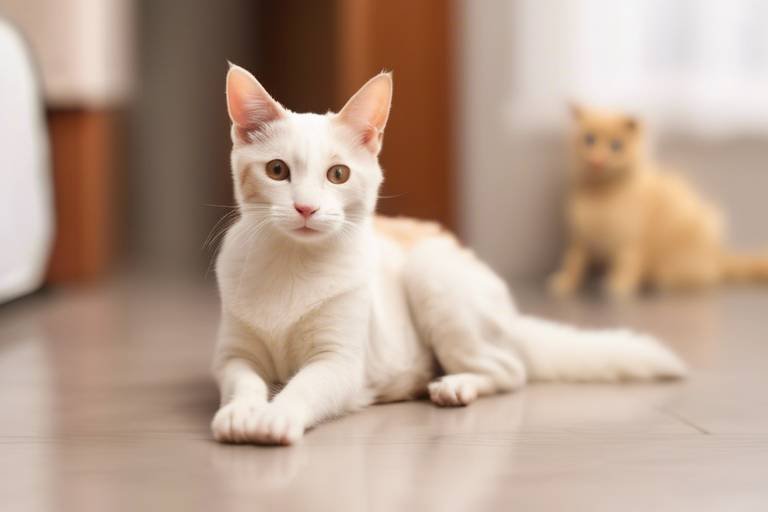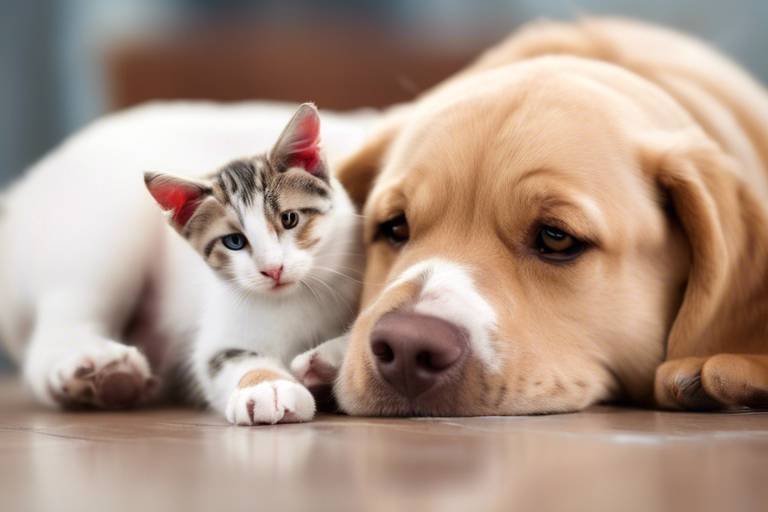How to Safely Introduce New Pets to Your Home
Introducing a new pet into your home can be an exhilarating yet daunting task. It's not just about bringing a new furry friend into your life; it's about ensuring that every member of your household, both two-legged and four-legged, feels comfortable and safe. Imagine the excitement of a new puppy or kitten, but also the potential chaos if your existing pets feel threatened or anxious. This article will guide you through the essential steps and considerations for introducing new pets to your home, ensuring a smooth transition for everyone involved.
Recognizing the unique personalities of your existing and new pets is crucial. Just like humans, pets have their own quirks and temperaments. Some pets might be social butterflies, eager to make new friends, while others could be more reserved and territorial. Understanding these differences can help you predict their reactions and interactions during the introduction process. For instance, if your current pet is a bit shy, introducing them to a boisterous new pet might require a more gentle approach. Always remember, patience is key. You wouldn’t rush a first date, right? The same goes for your pets!
Creating a safe and welcoming environment is essential for both new and existing pets. Before bringing your new pet home, take some time to prepare your space. This means removing any items that could pose a danger, such as toxic plants or small objects that could be swallowed. Additionally, consider the layout of your home. Are there areas where your pets can retreat if they feel overwhelmed? Setting up a comfortable and secure environment will help reduce stress and promote comfort for everyone involved.
Providing designated areas for each pet can help minimize territorial disputes. Think of it as giving each pet their own little sanctuary. You can create these spaces by using crates, separate rooms, or even cozy corners filled with their favorite blankets and toys. This way, when the new pet arrives, your existing pets will have a safe haven to retreat to if they feel threatened. It's like giving them a safe zone where they can chill out and gather their thoughts.
Gates and barriers can be useful tools for managing introductions. Imagine a bouncer at a club, carefully monitoring who gets in and who stays out. Similarly, using baby gates or pet barriers can help control interactions between your pets during the initial meeting. This allows them to see and smell each other without direct contact, which can ease tension and curiosity. Just remember to supervise these interactions closely, as you want to ensure that everyone feels safe and secure.
Incorporating familiar items from both pets can ease anxiety. For example, if your new pet has a favorite toy or blanket, bring it along when you introduce them to their new home. Similarly, ensure your existing pets have their comfort items nearby. These familiar scents can create a sense of security and help ease the transition. It’s like wrapping yourself in a warm blanket on a cold day — comforting and reassuring.
Taking gradual steps in introducing pets can lead to more successful interactions. Start by allowing them to sniff each other’s belongings before they meet face-to-face. Then, let them see each other from a distance, gradually bringing them closer together as they become more comfortable. This slow and steady approach can help prevent overwhelming either pet. Think of it as building a bridge; you want to ensure it’s strong enough to support both sides before crossing over.
Observing the initial interactions between pets is vital. Keep an eye on their body language and behavior. Are they relaxed, or do they seem tense? Intervening when necessary can prevent negative experiences. If you notice any signs of aggression or fear, don’t hesitate to separate them and try again later. Remember, it’s all about creating a positive experience for both pets.
Understanding stress signals in pets can prevent negative experiences. Common signs to look out for include:
- Hiding or seeking refuge in a corner
- Excessive barking or growling
- Tail between the legs
- Loss of appetite or reluctance to play
By recognizing these signs early, you can take steps to alleviate their stress and create a more harmonious environment.
Using positive reinforcement can encourage good behavior during the introduction. Reward your pets with treats or praise when they interact calmly with each other. This not only reinforces their good behavior but also helps them associate each other with positive experiences. It’s like throwing a little party every time they get along — who doesn’t love a good celebration?
Establishing a long-term plan for cohabitation is essential for harmony. It’s not just about the initial introduction; it’s about fostering a lasting relationship between your pets. Regularly engaging them in activities together, like playtime or walks, can help strengthen their bond over time. Think of it as nurturing a friendship — it takes time, effort, and a little love.
Q: How long does it take for pets to get used to each other?
A: It varies by individual pets, but it can take anywhere from a few days to several weeks. Patience is key!
Q: What if my pets don’t get along?
A: If things don’t improve, consider consulting a professional animal behaviorist for help.
Q: Can I introduce a new pet to my home if I already have multiple pets?
A: Yes, but it may require more careful planning and gradual introductions to ensure everyone feels secure.

Understanding Pet Personalities
When it comes to introducing new pets into your home, understanding pet personalities is absolutely crucial. Just like humans, every pet has its own unique traits, quirks, and temperaments that influence how they interact with others. For instance, some pets are naturally social butterflies, eager to make friends and explore their surroundings, while others may be more reserved or even a bit territorial. Recognizing these differences can help you predict how your pets will react during the introduction process, ultimately leading to a smoother transition.
Consider your existing pet's personality. Is your dog a playful retriever who loves to chase after anything that moves? Or is your cat more of a laid-back observer, preferring to lounge in the sun? Understanding these traits allows you to tailor your introduction strategy. For example, a lively dog may need more supervision around a timid cat, while two playful dogs might hit it off right away. It's all about reading the room—or in this case, the home!
Similarly, when bringing a new pet into the mix, take a moment to assess its personality as well. Is it a curious kitten ready to pounce on anything that moves, or an older dog set in its ways? Knowing these characteristics will help you create an environment where both animals feel comfortable. You may want to consider the following aspects:
- Energy Levels: High-energy pets may need more playtime and stimulation, while low-energy pets might appreciate a quieter space.
- Socialization: Some pets thrive on social interaction, while others prefer solitude. Matching these needs can prevent conflicts.
- Territorial Behavior: Pets that are more territorial may require additional time and space to adjust to a newcomer.
By taking the time to understand both your existing and new pets, you can better anticipate their reactions and interactions. This understanding fosters a sense of empathy and patience during what can be a stressful time for all involved. Remember, just like in a human family, some pets may take longer to warm up to each other, and that’s perfectly okay. The key is to be observant and flexible, adapting your approach as needed.
In summary, understanding pet personalities is not just about knowing who likes to play and who prefers to nap; it's about creating a harmonious environment where all pets feel safe and loved. By being aware of their individual traits, you can set the stage for a successful introduction and a happy, blended family.
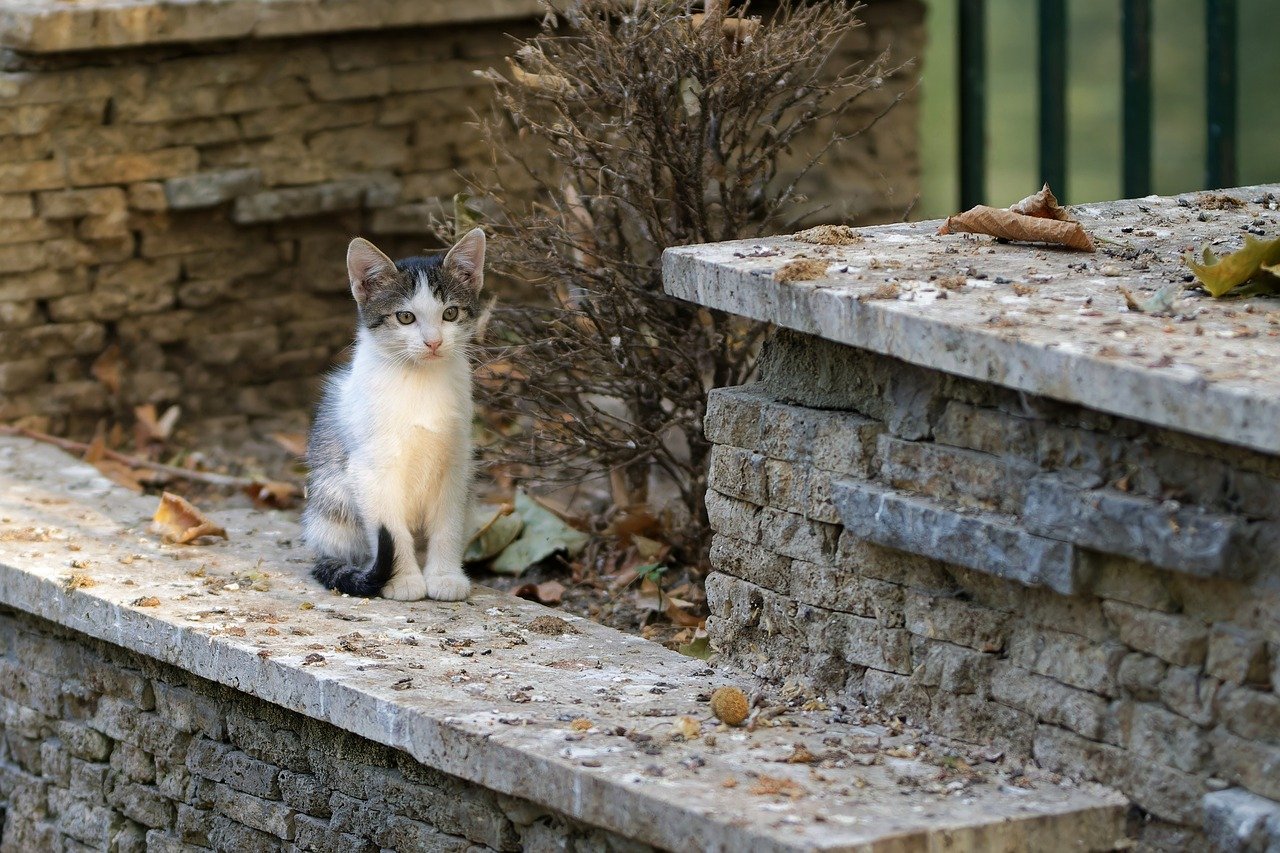
Preparing Your Home
When it comes to welcoming a new pet into your home, preparation is key. Think of it as setting the stage for a grand performance—every detail matters! A well-prepared environment can significantly reduce stress for both your existing pets and the new arrival. The first step is to assess your living space and identify areas that can be modified to create a safe and welcoming atmosphere. This means ensuring that each pet feels secure and has their own space to retreat to when needed. After all, pets, much like us, appreciate having their own little corners to call home.
One effective strategy is to designate specific areas for each pet. This helps in minimizing territorial disputes and allows for a smoother transition. For instance, you might set up a cozy corner for your new pet with their bed, toys, and food dishes, while ensuring that your existing pets have their own designated areas. This way, everyone knows where they belong, reducing the chances of conflicts. Consider using gates or barriers to create these safe spaces, allowing pets to see and smell each other without direct contact. This gradual exposure can ease the introduction process and make it less overwhelming.
Creating designated areas can be as simple as rearranging furniture or utilizing pet gates. Think of these spaces as personal sanctuaries where your pets can feel comfortable and secure. For example, if you have a dog, you might set up a cozy crate in a quiet corner of the living room. For a cat, a high perch or a secluded nook can serve as a perfect hideaway. The goal is to provide each pet with a space where they can retreat to feel safe, especially during the initial introductions.
Gates and barriers are invaluable tools in managing pet introductions. They allow you to control the interactions between your pets while still letting them observe each other. Imagine it like a staged play where the actors are gradually introduced to each other. You can start by allowing them to see and smell each other through the gate, which can spark curiosity without the risk of confrontation. Over time, as they become more comfortable, you can slowly increase their interaction time.
Incorporating familiar items from both pets can work wonders in easing anxiety. Just as we find comfort in familiar scents and belongings, pets also thrive on these reassuring cues. You might consider placing a blanket or a favorite toy from your existing pet in the new pet’s area. This not only provides a sense of familiarity but also helps in creating positive associations between the pets. Remember, the more comfortable they feel, the smoother the introduction process will be.
Ultimately, preparing your home is about creating a harmonious environment where both new and existing pets can thrive. By taking the time to establish safe spaces, using gates to manage interactions, and providing comfort items, you are setting the stage for a successful introduction. Just like any great performance, a little preparation can go a long way in ensuring that everyone plays their part beautifully!
Designating Safe Spaces
When introducing new pets into your home, one of the most important steps you can take is to designate safe spaces for each animal. This means creating specific areas where your pets can retreat to feel secure and comfortable. Think of it as giving each pet their own little sanctuary, a place where they can relax and not feel threatened by the presence of another animal. This is especially crucial for pets that are more anxious or territorial by nature.
To create these safe spaces, you can utilize different rooms or sections of your home. For example, if you have a dog and a cat, you might want to set up a cozy corner in your living room for the dog, complete with their favorite bed and toys, while allowing the cat to have a quiet perch on a high shelf in a separate room. This way, both pets can have their own areas that they can claim as their own, reducing the likelihood of conflict. Think of it like setting up a peace treaty—each party has their territory, which helps to keep the peace.
Additionally, it’s essential to ensure that these spaces are equipped with the necessary items that make your pets feel at home. This includes their food and water bowls, toys, and even blankets or bedding that smell like them. Familiar scents can have a calming effect and help to ease anxiety during the introduction process. You might also consider using pet gates to physically separate these areas while still allowing pets to see and smell each other. This gradual exposure can help them get used to each other's presence without the stress of direct interaction.
Another effective strategy is to rotate the pets in and out of these designated safe spaces. This allows each pet to explore the home at their own pace, while also getting used to the smells and sounds of the other animal. By doing this, you’re not only giving them a chance to acclimate but also helping them to build confidence in their new environment. Remember, the goal here is to create a stress-free atmosphere where both pets can feel secure and eventually come together.
In summary, designating safe spaces is a fundamental step in the introduction process. It involves creating separate areas for each pet that are filled with familiar comforts and gradually introducing them to each other while ensuring they have their own safe zones to retreat to. This thoughtful approach can significantly reduce anxiety and promote a smoother transition for everyone involved.
Using Gates and Barriers
When you're introducing new pets into your home, gates and barriers can be your best friends. Think of them as the safety nets that help you manage the initial chaos of introductions. They provide a physical separation that can make all the difference, especially when emotions run high. Imagine trying to navigate a crowded room; having a bit of space allows everyone to breathe and feel more at ease. By using gates and barriers, you can control interactions and prevent any potential confrontations, allowing both your existing and new pets to adjust at their own pace.
It's important to choose the right type of gate or barrier for your home. Some pets are more determined than others, so a sturdy gate is essential. There are various options available, from pressure-mounted gates that are easy to install and remove, to hardware-mounted gates that offer a more permanent solution. You might also consider pet playpens that can create a safe play area for the new pet, keeping them contained while everyone gets used to each other. Here’s a quick table comparing the types of gates you might consider:
| Type of Gate | Pros | Cons |
|---|---|---|
| Pressure-Mounted | Easy to install, no tools required | May not be suitable for strong or large pets |
| Hardware-Mounted | Very secure, great for large pets | More complex installation |
| Pet Playpen | Versatile, can be moved around | Can take up more space |
When setting up these barriers, consider the layout of your home. You want to create a flow that allows pets to see and smell each other without direct contact initially. This setup not only helps in reducing anxiety but also allows them to get accustomed to each other's presence. You might want to place the gate in a high-traffic area where they can observe each other while still feeling secure in their own space.
Remember, the goal here is not just to keep them apart but to facilitate a positive introduction. Allow them to interact through the gate, rewarding calm behavior with treats or praise. This way, the gate becomes a bridge rather than a barrier, fostering curiosity and reducing fear. Think of it like a first date—both parties need to feel comfortable before diving into a deeper relationship.
Ensuring Comfort Items
When it comes to introducing new pets to your home, are a crucial aspect that can significantly ease the transition for both your new and existing furry friends. Just like humans, pets thrive on familiarity, and having their favorite items around can create a sense of safety and belonging. Imagine how you’d feel if you were suddenly placed in a new environment without your favorite blanket or pillow! Your pets experience similar emotions, so let's dive into how to make their introduction as smooth as possible.
First and foremost, consider incorporating items that belong to your new pet into your home before the official introduction. This could be anything from their favorite toys to a cozy bed or even a blanket that carries their scent. By allowing your existing pets to explore these items, you’re giving them the opportunity to get used to the new scent without direct contact. It’s a bit like a sneak peek of what’s to come, and it can help reduce anxiety. You might find that they sniff curiously, which is a good sign!
In addition to this, it’s equally important to ensure that your current pets have their comfort items available as well. This balance helps maintain their sense of security during what can be a stressful time. For example, if your existing dog has a specific toy or blanket they love, make sure it’s accessible during the introduction process. This way, they can retreat to their comfort zone if they feel overwhelmed.
Another great way to enhance comfort is by creating a safe zone for each pet. This could be a separate room or a designated area in your home where they can feel secure. Fill these spaces with their favorite items, including toys, beds, and even some treats. By providing a sanctuary, you’re allowing them to adjust at their own pace. Remember, patience is key!
Lastly, don’t underestimate the power of familiar scents. You can help your new pet acclimate by introducing them to items that smell like your existing pets, and vice versa. A simple way to do this is by gently rubbing a cloth on one pet and then allowing the other pet to sniff it. This method can help them become accustomed to each other’s scents before they even meet face-to-face. It’s all about building a bridge of familiarity and comfort.
In conclusion, ensuring comfort items for both your new and existing pets is a vital step in facilitating a peaceful introduction. By creating a comforting environment filled with familiar scents and beloved items, you’re setting the stage for a harmonious coexistence. Just remember, the goal is to make everyone feel safe and loved during this transition. After all, a happy pet is a well-adjusted pet!
Gradual Introductions
When it comes to introducing new pets into your home, the key to success lies in patience and a well-thought-out approach. Just like humans, pets need time to adjust to new companions. Rushing the process can lead to stress, anxiety, and even aggression. Instead, think of the introduction as a delicate dance, where each step must be carefully choreographed to ensure harmony.
Start by allowing your new pet to explore their new environment while keeping them separated from your existing pets. This initial phase is crucial as it gives each pet a chance to acclimate to the new scents and sounds without direct interaction. You might want to set up a separate room for the newcomer, filled with their own toys, bed, and food. This space serves as a safe haven, where they can feel secure and begin to adjust to their new surroundings.
Once your new pet seems comfortable, it’s time to introduce them to your existing pets. However, rather than throwing them all together at once, try a gradual approach. Start with short, supervised meetings. Use a baby gate to allow them to see and smell each other without direct contact. This way, they can get used to one another’s presence without the pressure of a face-to-face encounter. Patience is key here; let them take their time to sniff each other through the gate.
During these initial introductions, be sure to monitor their body language closely. Look for signs of curiosity or calmness, such as relaxed ears and a wagging tail. If you notice any signs of aggression or fear, it’s important to separate them immediately and try again later. Remember, every pet has their own pace, and it’s essential to respect that.
After a few successful meetings through the gate, you can start to allow short, supervised interactions in a controlled space. Keep these sessions brief at first, gradually increasing the time they spend together as they become more comfortable with each other. During these interactions, use positive reinforcement to reward calm behavior. Treats, praise, and affection can go a long way in building positive associations.
As the days go by, continue to mix their scents by exchanging toys or bedding. This can help them feel more familiar with each other even when they’re apart. Eventually, you’ll reach a point where they can be together without any barriers. However, always keep an eye on them during these interactions until you’re confident that they can coexist peacefully.
In conclusion, introducing new pets gradually not only helps reduce anxiety but also fosters a sense of security for both your existing and new pets. Remember, this process is not a race; it’s about building relationships and ensuring that everyone feels safe and comfortable in their home.
- How long does the introduction process take? The timeline can vary depending on the pets' personalities, but it typically takes anywhere from a few days to several weeks.
- What should I do if my pets don't get along? If you notice aggressive behavior, separate them immediately and try again later. Sometimes, seeking advice from a professional trainer can be beneficial.
- Can I use treats to encourage positive behavior? Absolutely! Using treats is a great way to reinforce calm behavior during introductions.
- Is it normal for pets to be curious or cautious? Yes, it’s completely normal for pets to show curiosity or caution when meeting a new companion. Give them time to adjust.

Monitoring Interactions
When introducing new pets to your home, monitoring their interactions is crucial for ensuring a harmonious environment. Just like humans, pets have their own personalities and quirks, which can lead to unexpected behaviors during the initial meet-and-greet. So, how do you keep a close eye on these interactions without overwhelming either pet? The key is to observe their body language and reactions closely.
Start by designating a neutral space for the first introduction. This area should be free from any strong scents or territorial markings from your existing pet. As the pets meet, watch for signs of curiosity or aggression. Positive behaviors like sniffing each other or play bows indicate a friendly interest. In contrast, growling, hissing, or stiff body posture can signal discomfort or aggression. Being able to recognize these signals early on can help you intervene if necessary.
It’s also important to have a plan in place for intervention. If things start to escalate, you might need to step in and separate the pets. Use a calm voice to redirect their attention, or gently separate them using a barrier like a baby gate. This allows them to see and smell each other without direct contact, reducing the chance of a negative experience. Remember, patience is key. Rushing the introduction can lead to stress and anxiety for both pets.
During these interactions, keep a journal or notes on their behaviors. Documenting what happens can help you identify patterns or triggers that might cause stress. For instance, if one pet seems particularly anxious around loud noises, you can work on desensitizing them to those sounds gradually. This not only helps in the current situation but also prepares you for future introductions.
Additionally, consider implementing a
| Behavior | Interpretation |
|---|---|
| Tail wagging | Excitement or happiness |
| Hissing or growling | Discomfort or aggression |
| Play bowing | Invitation to play |
| Averted gaze | Stress or submission |
Finally, always reward calm behavior with treats or praise. This positive reinforcement can go a long way in building a friendly relationship between your pets. By being observant and proactive, you can help create a peaceful coexistence that benefits everyone in your household.
Q: How long should I monitor my pets' interactions?
A: It's important to monitor interactions for as long as it takes to ensure both pets are comfortable. This can range from a few days to several weeks, depending on their personalities.
Q: What should I do if my pets don't get along?
A: If you notice signs of aggression or extreme stress, separate them and try reintroducing them gradually. Consult a veterinarian or animal behaviorist if issues persist.
Q: Can I use toys during the introduction process?
A: Yes, but be cautious. Some pets may become possessive over toys. Start with neutral items that don’t belong to either pet to avoid territorial disputes.
Recognizing Signs of Stress
When introducing new pets to your home, it's essential to be vigilant about their emotional well-being. Just like humans, pets can experience stress during transitions, and recognizing the signs early can make a world of difference. Imagine bringing a new member into your family, and instead of excitement, you notice your furry friend is acting like they just sat through a boring lecture. The first step is to know what to look for.
Common signs of stress in pets can manifest in various ways. For instance, you might observe changes in their eating habits. If your normally voracious dog suddenly turns their nose up at their favorite kibble, that’s a red flag. Similarly, if your cat, who usually lounges around, starts hiding under the bed, it’s time to take notice. Other signs include:
- Excessive barking or meowing: This can be a cry for attention or a sign of anxiety.
- Aggression: If your pet displays aggressive behavior, it could be a sign that they feel threatened.
- Restlessness: Pacing or inability to settle down can indicate discomfort.
- Changes in grooming habits: Over-grooming or neglecting grooming can signal stress.
It's crucial to understand that every pet is unique, and their stress indicators may vary. For example, some dogs may react by becoming clingy, while others might withdraw into themselves. Cats, on the other hand, often display stress through hissing or swatting. Keeping a close eye on your pets during this transition period will help you gauge their comfort levels and intervene when necessary.
Additionally, observing their body language can provide valuable insights. A relaxed pet will typically have a loose body posture, while a stressed pet may exhibit tense muscles, lowered tails, or flattened ears. If you notice these signs, it’s a good idea to create a calming environment. Consider using soothing music or pheromone diffusers designed to help pets feel more at ease.
In conclusion, being attuned to your pets' emotional states is crucial during the introduction phase. By recognizing the signs of stress and responding appropriately, you can foster a more harmonious environment for both your new and existing pets. Remember, patience is key! Just like a new relationship, it takes time for everyone to adjust and find their rhythm.
Q: How long does it typically take for pets to adjust to each other?
A: The adjustment period can vary widely depending on the pets' personalities and past experiences, but it usually takes anywhere from a few days to several weeks.
Q: What should I do if my pets are showing signs of aggression?
A: If aggression occurs, it's best to separate the pets immediately and consult a professional trainer or behaviorist for guidance.
Q: Are there any products that can help reduce pet stress during introductions?
A: Yes, there are various products available, such as calming collars, sprays, and diffusers that can help ease anxiety in pets.
Q: How can I tell if my pet is happy with the new addition?
A: Signs of a happy pet include relaxed body language, playfulness, and a willingness to engage with the new pet.
Positive Reinforcement Techniques
When it comes to introducing new pets into your home, positive reinforcement can be a game changer. Imagine this: you're trying to teach a toddler to share their toys. Instead of scolding them for not sharing, you praise them when they do. This same principle applies to pets! By rewarding your furry friends for calm and friendly behavior, you can encourage them to build positive associations with each other.
So, how can you effectively use positive reinforcement during the introduction process? First, it’s essential to have some treats on hand—think of them as little tokens of appreciation for good behavior. Whether it’s a piece of kibble, a favorite chew toy, or a gentle stroke behind the ears, these rewards can motivate your pets to act in ways that promote harmony. When your new pet approaches your existing pet without growling or hissing, that’s the moment to reward them!
Additionally, timing is everything. You want to deliver the reward at the exact moment of good behavior. This helps your pet make the connection between their actions and the reward. For instance, if your dog sits quietly while your cat explores the room, give them a treat right then and there. It’s like saying, “Yes! This is what I want you to do!”
Moreover, you can incorporate verbal praise into your reinforcement techniques. A cheerful “Good boy!” or “You’re such a good girl!” can go a long way in making your pets feel appreciated. Pairing your praise with treats creates a positive feedback loop that encourages them to repeat the desired behaviors.
It’s also important to remember that each pet is unique. What works for one may not work for another. Some pets may respond better to treats, while others might thrive on verbal praise or petting. Therefore, it’s essential to observe your pets and adjust your approach accordingly. A little experimentation can go a long way in discovering what makes your pets feel rewarded.
In some cases, you might want to consider using a clicker training method. This involves using a small device that makes a clicking sound when your pet exhibits the desired behavior. The click serves as a marker, followed by a reward. This technique can be particularly effective for more complex behaviors, as it helps pets understand exactly what they are being rewarded for.
Lastly, patience is key. Just like humans, pets need time to adjust and learn. Celebrate the small victories, and don’t be discouraged by setbacks. With consistent positive reinforcement, you’ll create an environment where both your new and existing pets can thrive together.
- How long does it take for pets to adjust to each other?
Adjustment times vary, but with proper introductions and patience, many pets can learn to coexist peacefully within a few weeks. - What if my pets don’t seem to get along at all?
Sometimes, pets may need more time or additional training. Consider consulting a professional animal behaviorist if issues persist. - Can I use toys as positive reinforcement?
Absolutely! Toys can be a great reward, especially if your pet enjoys playtime. Just be sure to supervise interactions to avoid any territorial disputes.
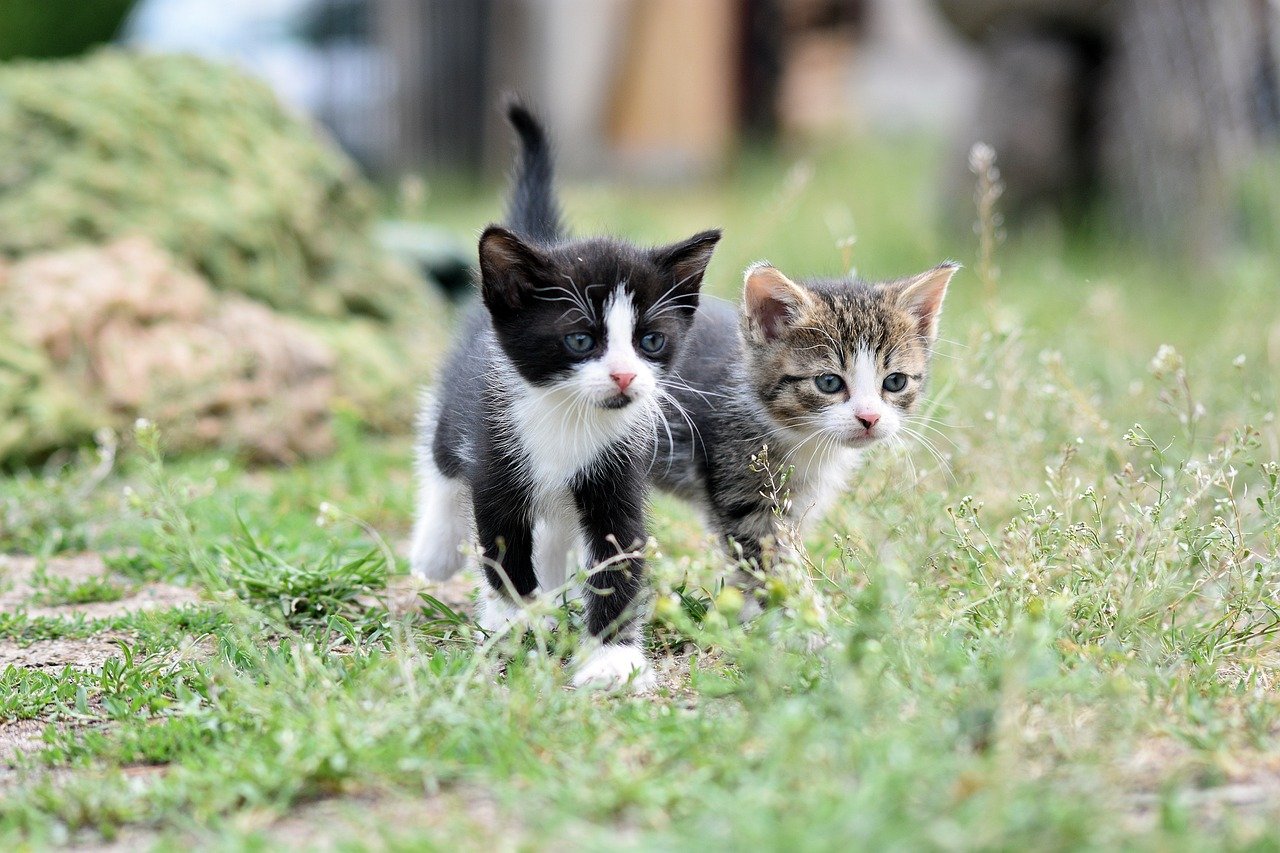
Creating a Long-Term Plan
Establishing a long-term plan for cohabitation is essential for ensuring harmony among your pets. Just like any relationship, it takes time, patience, and a bit of strategy to foster a peaceful environment where every furry (or scaly) friend feels safe and secure. Think of it as laying the groundwork for a new family dynamic; you want everyone to feel included and valued. So, how do you go about creating this plan?
First and foremost, it's crucial to set realistic expectations. Not every pet will become best friends overnight, and that's perfectly okay. Some may take weeks or even months to adjust to their new housemates. During this period, it’s important to maintain a consistent routine. Pets thrive on predictability, and having a structured daily schedule can help reduce anxiety. Here are some key elements to consider:
- Feeding Times: Ensure that feeding times are consistent for all pets. This helps in establishing a routine and reduces competition over food.
- Playtime: Schedule regular play sessions, but keep them separate initially. Gradually introduce joint playtime as pets become more comfortable with each other.
- Exercise: Regular walks or play sessions can help alleviate stress and energy buildup, making interactions smoother.
Next, keep in mind that individual attention is just as important. Each pet has its unique personality and needs, so it’s vital to spend quality time with each one. This not only strengthens your bond with them but also helps them feel secure in their place within the household. You might find that giving each pet some individual time can ease any jealousy or anxiety they may feel towards one another.
Moreover, consider implementing training sessions that focus on socialization and obedience. Training doesn’t just teach commands; it also helps pets learn how to interact positively with each other. Simple commands like “sit,” “stay,” or “leave it” can be invaluable during introductions and interactions. Plus, rewarding them with treats or praise during these sessions reinforces good behavior, making future interactions more pleasant.
Another aspect of your long-term plan should involve environmental enrichment. Pets, like humans, need stimulation and variety in their lives. Providing toys, scratching posts, or climbing structures can keep them engaged and reduce the likelihood of boredom-induced conflicts. For instance, if you have multiple cats, consider creating vertical spaces like shelves or cat trees where they can explore and claim their territory without direct confrontation.
Lastly, don’t forget to monitor your pets’ interactions regularly. Keeping an eye on their behavior can help you catch any signs of stress or discomfort early on. If you notice any negative behaviors, such as hissing, growling, or excessive hiding, it might be time to reassess your approach. Remember, patience is key. If things don’t go as planned, don’t hesitate to take a step back and give your pets some space to breathe. Sometimes, a little distance can work wonders in mending relationships.
- How long does it take for pets to get used to each other? It varies by individual pets, but it can take anywhere from a few days to several months. Patience is essential.
- What signs indicate that my pets are stressed? Look for behaviors such as hiding, aggression, excessive barking, or changes in eating habits.
- Can I use calming products to help with introductions? Yes, products like pheromone diffusers or calming collars can assist in reducing anxiety during the introduction phase.
Frequently Asked Questions
- How do I know if my pets will get along?
Understanding your pets' personalities is key! Observe their behavior around other animals. Some pets are naturally more social, while others may be more territorial. Look for signs of aggression or stress in both your existing and new pets to gauge how they might react to each other.
- What should I do to prepare my home for a new pet?
Creating a welcoming environment is essential. Start by designating safe spaces for each pet, using gates or barriers to keep them separated initially. Make sure to include comfort items like blankets or toys that smell like them, which can help ease anxiety during the transition.
- How long does it take for pets to adjust to each other?
Every pet is different, so there's no one-size-fits-all answer. Some pets may warm up to each other within days, while others might take weeks or even months. The key is to take things slowly and allow them to set the pace of their interactions.
- What are the signs of stress I should look for?
Watch for behaviors like excessive barking, hissing, hiding, or aggressive posturing. If you notice your pets are not eating or are overly restless, these could be signs of stress. It's important to intervene gently and give them space if needed.
- Can I use treats to help with introductions?
Absolutely! Positive reinforcement is a fantastic way to encourage good behavior. Reward your pets with treats when they exhibit calm behavior around each other. This will help them associate each other with positive experiences.
- What if my pets don’t get along?
If things aren’t going smoothly, don’t panic! It’s crucial to separate them and give them time apart. Reassess the introduction process and consider seeking advice from a professional trainer or behaviorist who can help tailor a plan for your specific situation.
- How can I maintain harmony between my pets long-term?
Establishing a long-term plan is vital. Continue to monitor their interactions and provide positive reinforcement. Regular playtime, shared activities, and maintaining their individual safe spaces can help build a peaceful environment for all.


